The sacred in architecture reveals itself beside a roadside stall while you watch your batch of hot jalebis being made. The jalebi is a fabrication of the ubiquitous spiral; hence when you sink your teeth into one, with the juice exploding in your mouth, you know what spirals taste like.
But the jalebi is not a stand-alone spiral. When traced by the hands of an astute khansamah, squeezing a thick batter from a muslin cone, the jalebinama is always an interconnected community of swirling dervishes. If you examine a jalebi in transit to your mouth, it will speak of networked origins. Just as Planck’s Constant electrons veer away when they get too close to the nucleus centre, the Jalebian journey too veers radially away from the centre, short-circuiting circles by cutting across previous circumferences, morphing into a tangent that swirls into the maelstrom of another jalebi, ad-infinitum (or, at least as far as the encircling rim of the boiling cauldron permits). When the movement changes from circumferential to radial, you get the blobs of coiled baroque, periodic climaxes of jalebi consumption, and zones of maximal sweetness.

The radial is the escape route from the centre. Reaching the centre, you find the horizon forever deferred; the centre is not a place; it is where the centre takes place. After all, the labyrinth choreographed a dance before beginning architecture, the art of time preceding the art of space. Linger at your peril at the centre where the axis mundi passes through, the turning internalizes, continuing inside your head, returning ad nauseam, trapping you forever inside the labyrinth as a monster Minotaur. Thus, Jack Nicholson occupying the centre of the labyrinthine hotel in The Shining, doomed to loop a single sentence repeatedly, the unrelenting momentum of trapped gyrations having crossed the Schwarzschild radius of sanity. At the same time, his son gave up tricycling concentric corridors and took refuge in the freezing maze outside. Centre: a place of turning and not of tarrying—trespassers beware!
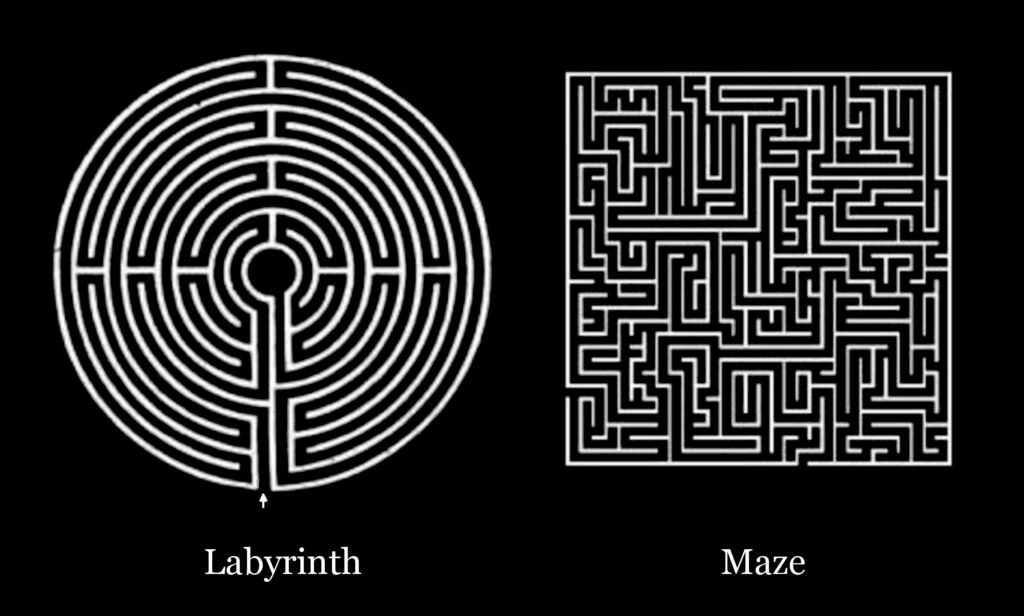
Hence, astute pilgrims move on. Muslims journeying from the other side of the world, a once-in-a-lifetime, on reaching Kaaba circumambulate in white akin to their eventual shrouds, their hearts/qalb displaced/lqab towards the dark draped centre as they perform the tawaf’s anticlockwise encircling with ihram less a robe and more a state of mind. They return home without entering the Kaaba, inside which star-crossed qibla-longitudes converge into the vertical axis mundi. The hajjis have quenched their thirst with the spring waters of Zamzam. Faraway, rows of worshippers every Friday inscribe segments of circumferences as distant ripples of tawaf circles. At the same time, the collective space of the mosque’s mihrab remains in radial migration to the Kaaba even as rows spill into streets. Praying under the open sky, worshippers recall praying in the Plain of Knowledge/Arafat by the Mount of Mercy, where thousands of hajis sheltered inside the solitary mosque. In contrast, millions from all over the world prayed simultaneously outside under the scorching desert sun. All bear witness to architecture’s profound inability to domesticate the sacred. Architecture remains a null program that runs automatically when the computer is idle, never taking no for an answer.
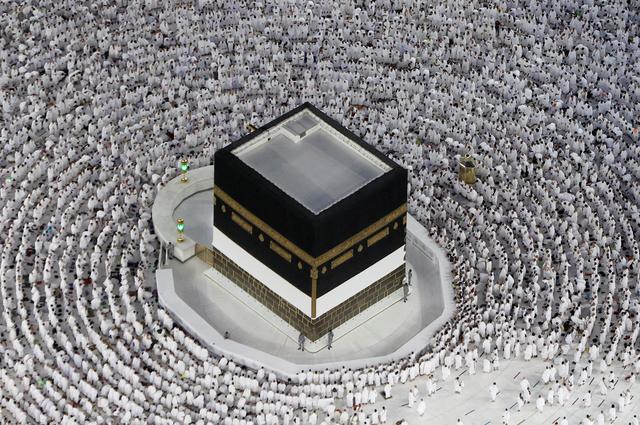
That said, the imminent plane of immanence pivoting around the axis of transcendence, the transhuman Kaaba is quintessential sacred architecture, the realm of the radical other revealed by being concealed. Hence the kiswa, the dark textile with its text in gold proclaiming the deterritorialization of all terrestrial axes, drapes the cube as an architectural hijab. The text that interweaves clockwise never deems itself holy; it describes itself as the Noble Quran or the Magnificent Quran and never as the Holy Quran. Just as the Kaaba it drapes is not a holy house but merely an ancient house of God: bait-ul atiq in the Quran. A worldview renders a word redundant when the sacred’s ubiquity, by definition, escapes definition. The journey hence is from qibla to qalb; you never left home.

Another ornate curtain, the parokhet, conceals the Torah housed in an Ark inside the Synagogue, just as cracks in the Wailing Wall as a Second-Temple-substitute, conceal prayers, tzetzels that are, by definition, ultimate disclosures on behalf of the absent Jew to the inexpressible, but omnipresent, other. The veil is also drawn to conceal the sanctum of the Eastern Church.
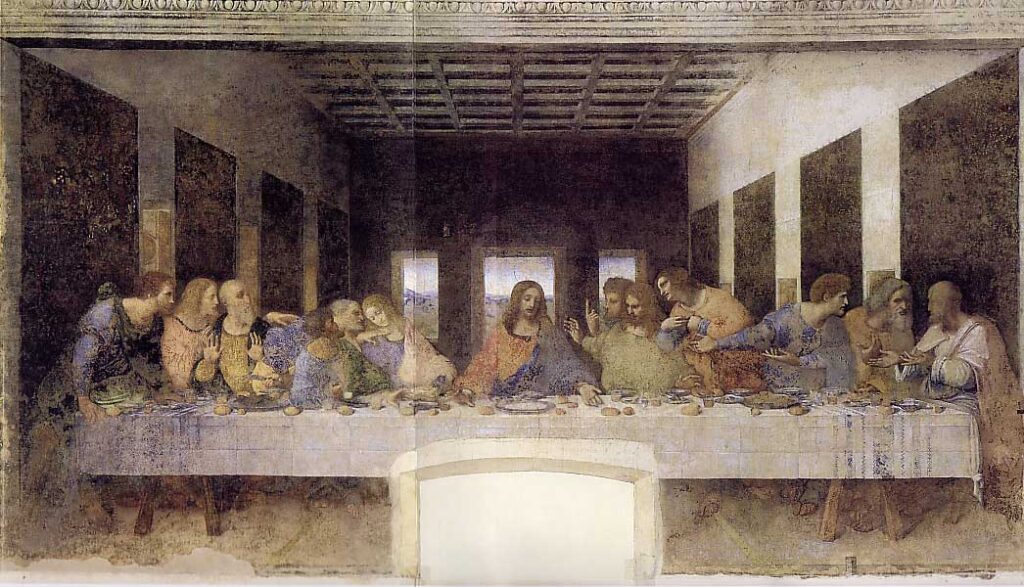
In the West, Sundays are a time of communing and recalling that redemption is by faith alone. The faithful that gather to perform rites of Eucharist or Communion also recall the Last Supper, where once upon a Tridentine time, long, long ago, men in white used to circumambulate the freestanding altar’s site of alterity, incensing it with fragrant smoke from a swaying thurible (thuein “to sacrifice”) dissolving the offer/offered/offering of sacrifice. In Leonardo Da Vinci’s iconic rendition, the horizon recedes behind the eyes of Christ, who occupies the geometrical, if not the numerical, centre; in that Church of Leonardo, he remains transfixed where the horizontal axis intersects the vertical axis mundi at the inception of transubstantiation as the dining table morphs into an altar even as the pigment of his painting continues to flake suffering smoke, steam and soot. The altar remains a site of promises made and kept, hearkening back to the archetypal Altar of Abraham with his willingness to sacrifice his willing son, the journey from submission to submission sparing them both—darkness in transit from light to light.
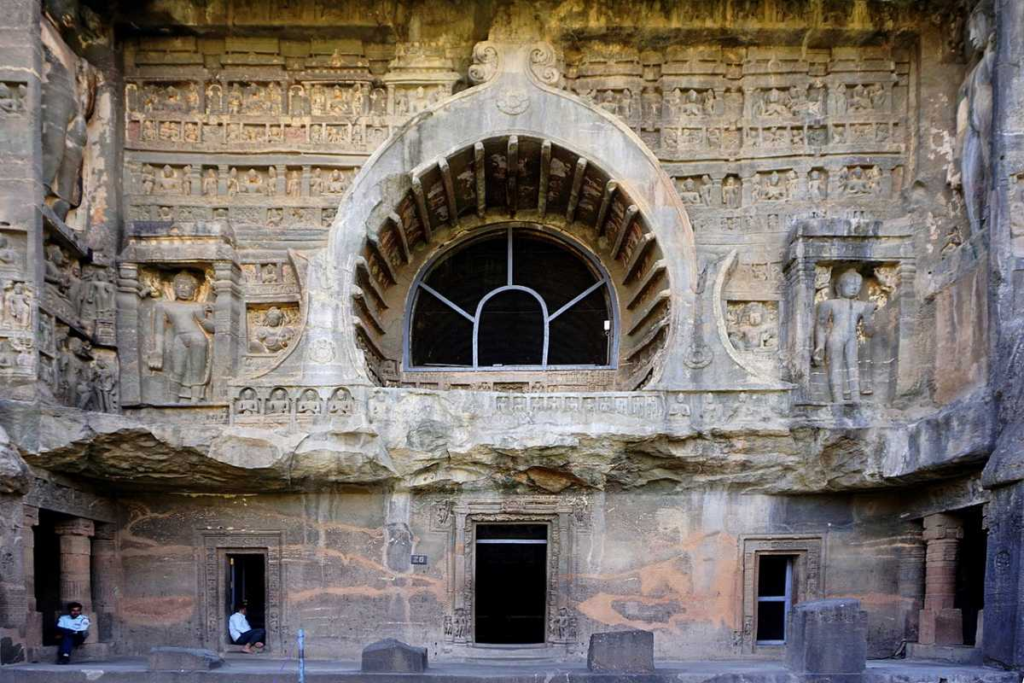
The Buddhist enters the Ajanta cave he moves from light to light via darkness. From the left entrance of the carved cave, moving from light into the ambulatory darkness that relents upon reaching the cavernous deep end, where the pathway turns behind the stupa towards the light of another exit. At Sanchi, she encircles the dome, bathed in sunlight, whose periphery is accessible as a multilevel circumambulatory, but the centre, receptacle of relics of the receding horizon, remains inaccessible to humans. Buddhists circumambulate the bodhi tree in Bodhgaya, Mount Kailash in Tibet (prostrating at each step) and the kaihogyo: a thousand-day circuit around Mount Hiei that eventually encircles Kyoto.
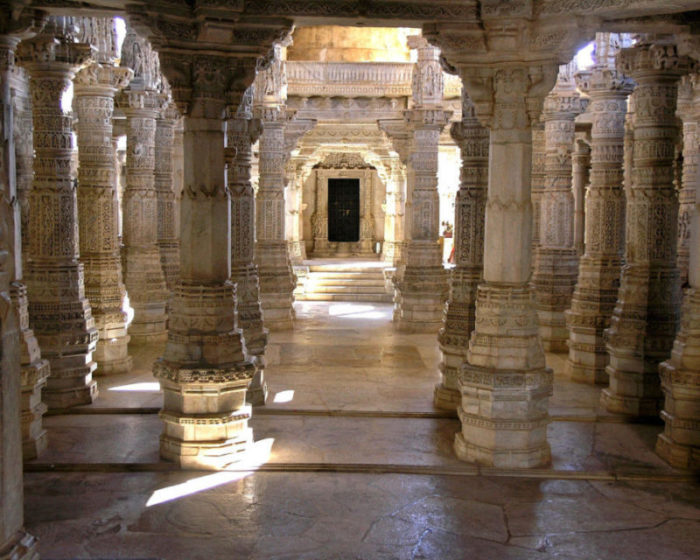
In the celestial circumambulations of day and night, the Jain awakens to the Namaskara Sutra in the ancient dialect of Ardha Magadhi, as old as Aramaic, that remains the final utterance on his lips before he slips back into sleep, a rehearsal of last words. When she walks the raised perambulatory of the exquisitely carved marble temple encircling the domed shrine clockwise three times to cultivate rightness: the first round for faith, the next for knowledge, and concluding with conduct. All the while, she regards the seated Tirthankara at the centre, not as the object of worship but as a conduit to the tirtha across stormy Samsara. Her namaskar to him is a pradakshina of folded hands encircling her face three and a half times, beginning at the left ear and ending at the right. Devotion is more orthopraxy than orthodoxy.
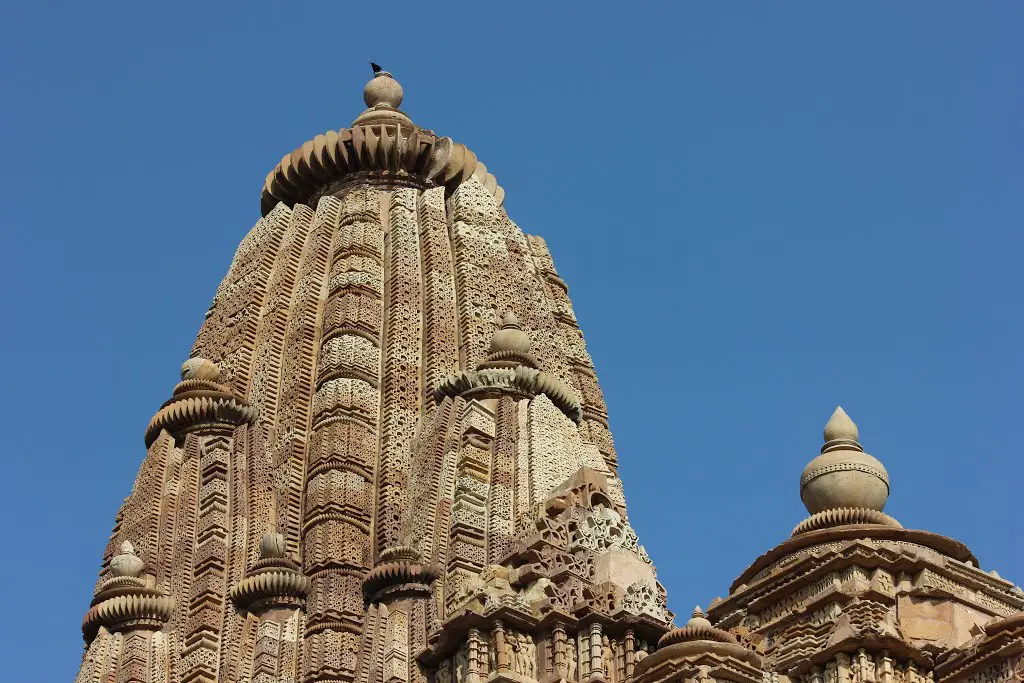
The Hindu enters towering gateways, but the inner sanctum recedes into the darkness where sight begins to yield to simulacra so that the heights of the towering shikhara remain impenetrable save for the garbgriha. This womb-chamber hosts not the worshipper but the locus of worship installed as prana-pratistha around which she performs pradakshina, just as she does around the Peepal tree in the praangan or Tulsi plant in her aangan, or the Girivalyam around the Annamalai Hill on the occasion of a full moon, much as Surya in the sky orbits Mount Meru, Ganesha on earth around his parents, and lovers seven times around the fire of their wedlock. At Kashi, the most sanctified of the SaptaPuri, the Panchakroshi circumambulation begins with a dip at Manikarnika kund of Ganga, with the next five days traversing barefoot, halting for the night always on the left side of the route, bathing in the teardrops of sage Kardam, catching a glimpse of one’s reflection in the dark well of Somanatheara, planting a sapling Gangaji mein jaun bo diya before returning where you began, to dip at the same station of the relentless river, emerging tired and yet rejuvenated having internalized the yatra. If not, rinse and repeat, or embark on Circumambulatory of Narmada that takes not five days but five barefoot months or longer if the monsoon turns the country into a cauldron.
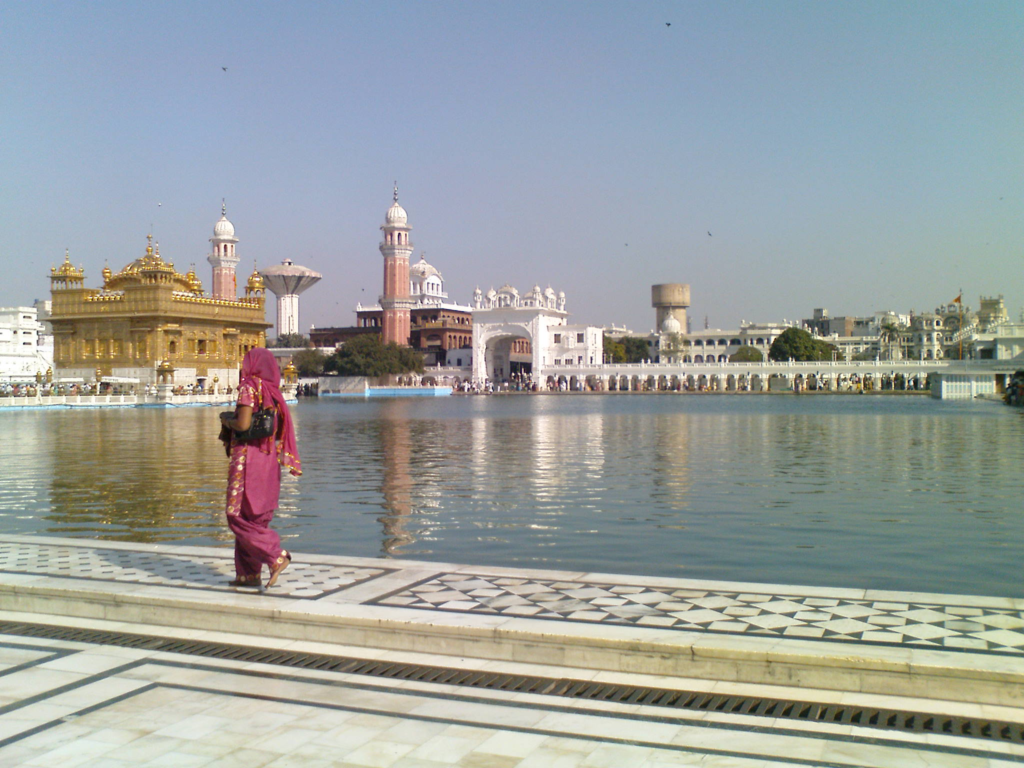
The Sikh’s parikrama entails going around the Sarovar (the pool of immortality) with the gleaming sanctum treasuring the Guru Granth Sahib under its canopy. Mian Mir Muhammad purportedly laid the foundation stone of the first temple; the latest iteration, the Golden Temple, glistens in the sun.
In the Zoroastrian Temple, water in multiple containers establishes the multiplicity of the horizontal plane while the fire, a singularity on a central axis, ascends the vertical axis mundi; the daily Yasna consumes and consecrates to conjure the final yasna at the end of time, to renovate the world.

In transit to the end of time, the sacred does not need architecture, but it does secrete architecture. Architecture is the persistence of a holding pattern, a process made visible. Returning to the steaming hot cauldron of jalebis being cooked on a chilly morning, you realize the blob of intense sweetness occurs within a jalebi’s delicate circumferences when the movement veers away along another circumambulation, around another centre from which it moves away, forever reaching out to an/other.
The jalebi is not designed to look like that; it is the trace left by the moving hand, a mapping of flowing matter in a free-fall into the liquid to achieve intimate interspaces, much as the equilibrium between figure and ground in Arabic calligraphy: Jalebi’s origin is in Arabic zalabia. The first letter of the language-of-languages permissible on the Kaaba is the vertical axis of alif, followed by the horizontal ba, veridical singularity in an ocean of horizontal tawafs. Jackson Pollock’s paintings are a trace left by the hand moving across the canvas; the painting itself is a retrospective glance at the journey of the moving body. So are jalebis a historical account of forelimb choreography; a spatial interpretation of time; ritual embodied a millennia ago in Kitab al-Ṭabīkḫ: The Book of Dishes by Abū Muḥammad al-Muẓaffar ibn Naṣr ibn Sayyār al-Warrāq of the 10th century Court of Abbasids, in the fairy tales of the royal kitchens of Baghdad, the dizziness of deserts begetting desserts.
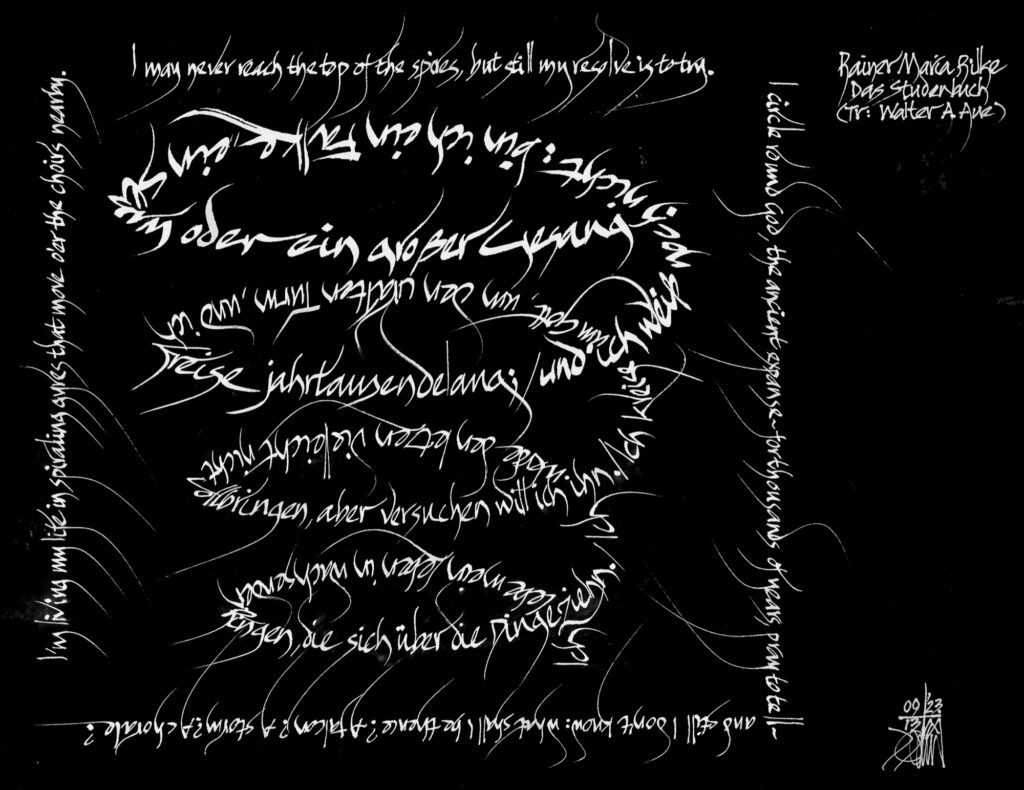
A necklace of holding patterns afloat: knots designed to snap away when removed from the originating cauldron and wrapped in the text of yesterday’s newspaper. Detached, yet, each jalebi recalls another, turning you into a serial spiral consumer of embodied light while revisiting the centre, again and again, only to flee with architecture as your accomplice and alibi.
Author’s Note:
Author’s Note: The red Jalebi Calligram, as well as the above Spiraling Calligram can both be downloaded from Academia. The reader may find islands of clarity amidst a sea of obscurity as the essay privileges the pilgrim over the tourist. The backstory of the essay is given in The Birth & Death of Essay. The essay first appeared fifteen years ago in its first iteration as Contours of the Sacred in International Gallerie and was reviewed by The Hindu).
Author:
H. Masud Taj has visited the Kaaba several times in several guises: once as a member of the Royal Pilgrimage, flying in King’s jets; staying in the palace overlooking the Kaaba; and once as a virtual pauper in retreat at the Great Mosque during Ramadhan, breaking fast with food sent by archetypal hosts – the ansars, residents of Medina.








